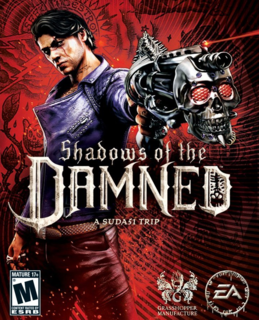Modern wannabe version of Dante's Inferno one might wish to play while drunk
So where Dante's hell is based on a multi-level cultural background, this underworld is just vulgar and flat, the only true humorist highlights coming from Johnson, Garcia's skull torch and sort-of intellectual lead, and some of the funnier revelations about the habits in the vast demon world one is accompanying the hero into in order to help him reconquer his girl robbed by Fleming, the local Lucifer.
Yet there is more ugliness to be encountered on this way: for instance in the visual design, particularly during the not rare boss fights, where one frequently gets to see the demons' and the scenery's structures with about microscopic closeness, i.e., almost from inside. In the often times devastating music score audibly accentuating the game so as to rise tension especially during the lengthy fight scenes. Or still in some of the game's functional failures, like the improper aiming –though the fancy weaponry named Hotboner (phallic pistol, plus sticky explosive), Dentist (machine gun, plus multiple targeting), Skullcussioner (shotgun, plus rolling bomb blaster) undoubtedly is one of the game's more enlightened ideas–, the unreliable health indicator, permeable walls where someone might stick out, or some of the demons' motor disorders, like running on a place (e.g., the one with electric curlers), though this might make defeating them a little bit easier.
This does not mean that all is bad what is to say about this game; in addition to the quite selective (and expensive!) drinks –Sake, Tequila, and Absinthe, providing 30, 70, and 200 HP, respectively– and demonic weapons, there undeniably are quite some nice ideas to be found, like the 2D demake episodes (Great Demon World Village & Forest), sweetened by a retro-tune on a Dave Brubeck's Take Five-like musical fond, the 3D-block-turning puzzles (library, castle), or The Big Boner mini-game (act 4-1) when having to shoot the approaching giant demons on a modern city's stage before they get too close. Or also the curious tales from Demon's world, related with Johnson's stiff-upper-lip British accent and commented by Garcia in his sloppy parlance mixed with Spanish terms, for instance "VIP" signifying "Very Important Pendejo" (imbecile), as well as some of the more entertaining-to-fight demons like the elusive ninjas, the spiked rolling boars, or even evil Fleming himself.
But also the rather delightful ideas here tend to be reiterated until becoming tedious, so one has to fight a same-type demon on at least three or four occasions in sequence, and also for the bosses some of which recall those of Shadow of the Colossus (e.g., George the beast) the same actions have to be repeated three or four times until finishing the foe entirely, what does not feel all too original.
And then, how much boss fight does the common action gamer need? as this feature here is surely dominating overall level design. Yet while Shadow of the Colossus' epic boss fights are an aesthetic pleasure visually, musically, and gameplay-wise, in Shadows of the Damned ugly graphics –superimposing structures together with the looming darkness and the injured-red progressively framing the screen if you run out of bottles–, unappealing sound design, and repetitive control mechanics (evasive dodging!) make some of the bosses, for instance the one with the third Sister Grim, Giltine, at the end of act 4-3, a quite unenjoyable experience. And even more so when further handicapped through Hotspur's clumsy movements if not jump-rolling all the time, the sometimes ill-angled inexact shooting applying in particular to the most vital light shots, the quite absurd charging times making the skullcussioner together with its skullblaster almost unusable whenever a quick reaction is needed, and in spite of the available upgrades, if any, as well as the quite fortuitous upgrade system itself.
It is possible to achieve the not quite easy game on Demon difficulty level with just 23 out of 80 available upgrades (which cannot be used for a second playthrough). Yet whereas in Dante's Inferno the soul points gotten through fighting the monsters permit acquiring diverse powerful skills assigned to the functional controller buttons, the upgrades in Shadows of the Damned are due to the precious red gems accidentally to be discovered on hell's way in crates, barrels, and behind doors, or rewarded when collecting all the available white ones, and just serve to enhance the three principal weapons' damage, capacity, and recharge time in addition to torch, light shot, and the hero's proper health expectation. Blue gems allowing the successive upgrade of Johnson's own skills and with this, also of the three weapon types he provides (e.g., teether to teethgrinder to dentist) are obtained upon finishing the different levels, while white gems, the local currency with which to buy drinks, ammo, or red gems from vending machines or the half-human shopkeeper Christopher, result from slaughtering the common demons along the way.
More outstanding even in this dark demon world are the reggae-tuned sushi-lamps and the bleating goat lamps needing to be switched on through light shots otherwise used to render vulnerable dark demons covered by dark matter, or the ubiquitous whining baby demon gates to be opened through feeding them brains, eyeballs – and strawberries, sort of tongues rising from the ground.
All in all a few truly original and maybe funny ideas designed to make Shadows of the Damned the modern wannabe version of Dante's Inferno which – if one liked whose classic touch– one might not know too well why to scoff.
Needless to say that there are no coop or online multiplayer options being offered and repeating the game lacks quite any incentive since the hardly achieved upgrades cannot be used for a second playthrough –like for Dante–, either.

